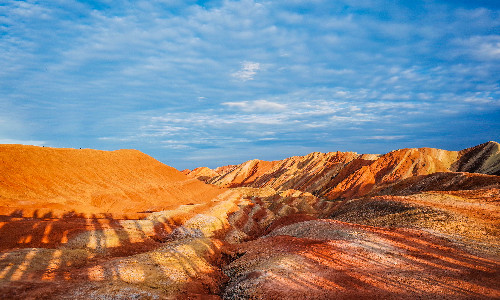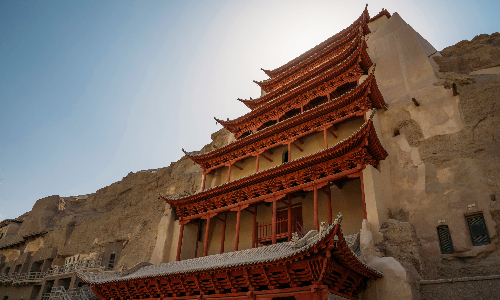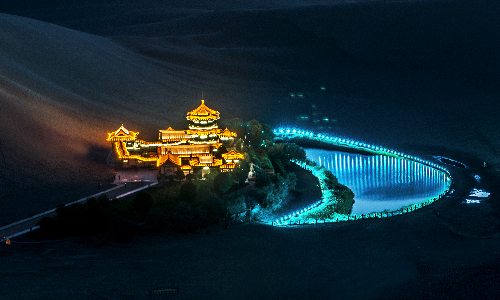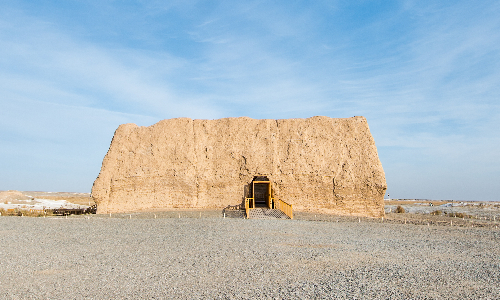This is a 6-day Zhangye Dunhuang Silk Road Tour. We will take you to the cities on the Silk Road directly. This is not only a great Silk Road tour, but also a wonderful photography tour. You will see the colorful Danxia landform, the world-famous Mogao Grottoes, the Crescent Lake which is located in the center of the desert, and so on. Besides this, it is also a Silk Road tour by train. Taking a train from Zhangye, you can enjoy the beautiful scenery along the way to Dunhuang. Read the following itinerary carefully and I am sure you will be attracted.

Our guide will meet you at the airport. And then you will be transferred to your hotel. You could have a good rest and prepare for your Zhangye-Dunhuang Silk Road tour.
The Silk Road is committed to advancing integration, exchange, and dialogue between East and West. It has made important contributions to the common prosperity of mankind for nearly two thousand years. Located in the northwestern region of China, Zhangye has been an important commercial town on the Silk Road since ancient times. In the Tang Dynasty, Zhangye became an important place for China's foreign trade. Zhangye's status in international trade has also reached an unprecedented peak. In addition to the prosperous history, Zhangye also owns diverse natural landscapes. Here you can see deserts, wetlands, snow-capped mountains, grasslands, lakes, etc. Also, the scenery in different seasons is different. It is a place that can be visited all year round. The weather here is characterized by short and hot summers, long and severe winters, and large temperature differences between day and night. So, we will recommend you to take proper clothes when you come to Zhangye.
Travel tips:
1. Zhangye has strong ultraviolet rays, please take sun protection measures.
2. The weather in Zhangye is dry, so drink plenty of water during travel.
3. It is easy to be windy in Zhangye. So, we will recommend you to tie the camera tightly with a waterproof bag or plastic bag to prevent sand and dust from entering.
4. Zhangye is an area where many ethnic groups gather. If you want to take photos of local ethnic minority residents, please ask for permission first.
This morning, we will first visit the Giant Buddha Temple which has a history of more than 900 years. This is one of the four existing royal temples in China. So, the building style of the whole temple is solemn. It is also a Buddhist art museum integrating architecture, sculptures, murals, scriptures, and other cultural relics. There are more than 6,000 volumes of Buddhist scriptures given by the emperor of the Ming Dynasty in the Depositary of Buddhist Texts. Some of which are written in gold and silver powder, and are well preserved. They are rare treasures of Buddhism. Besides, you can see the largest indoor clay reclining Buddha sculpture here. The total length of the Buddha sculpture is about 34.5 meters.
After lunch, we will visit the Zhangye Danxia National Geological Park. The total number of Danxia landforms in China is 790, concentrated in 26 provinces in the southeast, southwest, and northwest arid regions. Among them, the Zhangye Danxia landform covers an area of more than 536 square kilometers, which is the most typical and largest Danxia landform landscape in arid regions in China. It has been selected as one of the 25 dream destinations in the world by the global tourism website. This is a gift that nature gave us. Standing on the viewing platform, you can see the colorful mountains just like a color palette knocked over by God. The best viewing time for Danxia Landform is in the early morning and late afternoon. If you encounter the setting sun, the scenery will be much better. If it rains the day before, the sky will be clearer and the sun will be brighter. You will see more gorgeous colorful mountains.
Travel Tips:
1. It is best to wear a mask or headscarf as there always be a strong wind.
2. You’d better wear hiking shoes or other comfortable shoes. There is sandy soil near the Danxia landform.
3. The Danxia landform is very fragile, and the footprints on it cannot be restored for hundreds of years. Therefore, fences are set up in many places in the scenic area. You’ll have to abide by the regulations of the scenic area and don’t step on the red landforms.


 Dunhuang
Dunhuang After breakfast, you will take an estimated train D2749 11:25/16:20 to Dunhuang. Our guide will pick you up from the train station and take you to the hotel. You can have a rest in the hotel or you can walk around the city.
"Dunhuang" originally means grand in Chinese, and this word is enough to show the glorious past here. Located at the westernmost end of the Hexi Corridor, Dunhuang is a famous city on the ancient Silk Road. Historically, it was the only passage from the Central Plains to the Western Regions and even Europe. It was the meeting place of the four ancient civilizations of China, India, Greece, and Islam. Therefore, it is full of exotic customs. Dunhuang is a city with very long sunshine hours, and the day sunshine time in summer can reach 15 hours. Coupled with the large temperature difference between day and night, the fruits here are particularly sweet. When you come to Dunhuang, you cannot miss the fruits here.
In the morning, we will take you to visit Mogao Grottoes. Dunhuang, located at the junction of the North Silk Road and South Silk Road, was once a prosperous city, with flourishing trade and numerous temples. Buddhism was introduced to China from India and merged with Chinese traditional culture, leaving a large number of the cultural heritages of grottoes along the way. Among them, the Dunhuang Grottoes with Mogao Grottoes as the main body has the largest scale, the longest duration, the richest content, and is the best-preserved. In December 1987, the Mogao Grottoes in Dunhuang, Gansu were included in the "World Heritage List." It is famous for the murals, sculptures, and buildings. There are 492 colored sculptures in total. The largest one is more than 30 meters high and the smallest one is simply 2 centimeters high. The rich cultural relics make a deep impression on tourists. If you come here in summer, you can taste the ice cream here which is in the same shape as the Mogao Grottoes.
After lunch, we will visit the Mingsha Mountain (Echoing-Sand Dune) and Crescent Lake. The sand under the sun is scorching, and the ultraviolet rays are also super strong at noon, so we will arrange for you to visit Echoing-Sand Dune in the afternoon. In this way, you can avoid the sweltering heat in the desert. And you can climb to the top of the mountain and enjoy the scenery of the sand sea and Crescent Spring when the sun goes down. Taking the sand skiing as the way to go down the mountain is a good choice. When you slide down, you will hear the sounds like drums which is very interesting. If you want, you will also have a chance to ride a camel there.
Don’t forget to take photos of Crescent Spring. The unique shape and the jade green color will make you impressed. The Crescent Spring is nearly 100 meters long from north to south and 25 meters wide from east to west. The spring water is deep in the east and shallow in the west, and the deepest part is about 5 meters. Crescent Spring is curved like a crescent moon, hence the name. For thousands of years, deserts and droughts have not made this magical spring disappear. It is like an elf, bringing life to the barren desert.


After breakfast, we will take you to visit the Dunhuang Yardang National Geopark. The Yardang landform is a representative landform type in extremely arid regions. It is a Quaternary sediment formed after 100,000 years of erosion by wind and water as the main forces. The landscape of Yardang National Geopark is mainly divided into Yardang landscape, desert landscape, wetland landscape, and Gobi landscape. Among them, the Yardang landscape is the most shocking. The land was eroded into various shapes by the wind, some resembled a peacock showing its tail, some resembled a neatly arranged fleet, some resembled a castle, and some resembled a mysterious UFO.
After lunch, we will take you to visit the Yumen Pass. Yumen Pass is an important military pass in the Han dynasty. The existing relic site is square, and the surrounding walls are well-preserved. The existing city wall is 9.7 meters high, about 3 meters wide, and 5 meters at the widest point of the wall base. The walls are tamped down with yellow plastic soil and there are two gates on the north and west. The inner city is 24 meters long from east to west and 26.4 meters wide from north to south. There is an east-west road in the north of the city, which is the only way from the Central Plains to other countries at that time. Ancient relics of grain, silk, and linen have been found here.
Han Great Wall is not far from Yumen Pass. You may have visited the Great Wall in Beijing which is built of stones and bricks. But I think you haven’t seen this kind of Great Wall made of clay, tamarisk, and reeds. The Han Great Wall was an important part of the military defense system in the Han Dynasty, and it was also a historical epitome of the construction of the entire northern defense project constructed by the Western Han Dynasty. This part of the Han Great Wall you will see is the longest and most complete part of the whole existing Han Great Wall. The foundation is 3 meters wide, the residual height is 3 meters, and the top width is 1 meter. Next to the beacon tower, there are 15 piles of firewood used to ignite beacon fires, and they all have been condensed into fossils.

After breakfast, we will take you to the airport and you could fly back to your sweet home.
Option: If your flight is in the afternoon, we can take you to visit the Dunhuang Museum. Dunhuang is a city that witnesses the development of the ancient China Silk Road. You can see the cultural relics in different dynasties here. The exhibits here include gorgeous silk, precious jade, pottery figurines imitating the camel caravan at that time, and so on. They reproduced the prosperity of the Silk Road.
Editor: Betsy He
Proofreader: Carrie Zhang
| City | Five Star hotel list | Four Star hotel list |
|---|---|---|
| Dunhuang | Wan Sheng International Hotel | Grand Sun Hotel Dunhuang |
| Zhangye | Zhangye Hotel | Zhangye Dinghe International Hotel |
 |
![]() About your child or infant, please contact us for a discounted price.
About your child or infant, please contact us for a discounted price.



We started with a few days in Beijing & ended in Shanghai, from where we visited the Forbidden City and Great Wall. In between we visited Terra Cotta Warriors Museum, Panda Base, Shanghai Disneyland.

We had a wonderful holiday in China which will remain long in the memory. China is a breathtakingly beautiful country full of splendid temples and palaces, mountains and rivers, peaceful rural scenes and bustling shopping streets.
 QUICK ENQUIRY
QUICK ENQUIRY